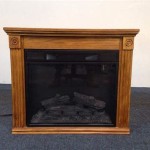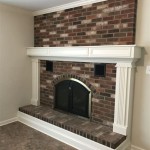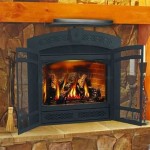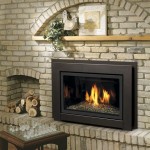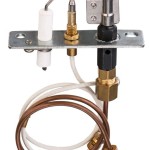Best Wood To Burn In House Fireplace
Selecting the appropriate wood for a house fireplace significantly impacts its efficiency, safety, and overall heating performance. Understanding the properties of different wood types, specifically their density, moisture content, and resin levels, is crucial for optimal fireplace use. Wood selection is not merely about generating heat; it's also about minimizing creosote buildup, reducing smoke emissions, and ensuring the long-term integrity of the chimney and fireplace system.
The heat output of firewood is measured in British Thermal Units (BTUs). Higher BTU ratings indicate that a wood type will produce more heat when burned. However, heat output is only one factor to consider. The burning characteristics, such as how easily the wood lights, how long it burns, and how clean it burns, are equally important for a pleasant and safe fireplace experience. Seasoned wood, with a moisture content below 20%, burns more efficiently and cleanly than green or unseasoned wood, regardless of the wood type.
Hardwoods Versus Softwoods
Generally, hardwoods are considered superior to softwoods for fireplace use due to their higher density. Higher density translates to more wood mass packed into the same volume, resulting in a higher BTU output. Hardwoods also tend to burn longer and produce less smoke than softwoods. However, some softwoods can be acceptable for fireplace use under specific circumstances, particularly for kindling or starting fires.
Hardwoods like oak, maple, ash, and birch are preferred for their slow-burning characteristics and high heat output. These woods create a steady, consistent fire and produce long-lasting coals. Softwoods, on the other hand, tend to burn quickly and produce more sparks and smoke due to their higher resin content. Examples of softwoods include pine, fir, spruce, and cedar. While these woods can be used for starting fires, they are not recommended for prolonged burning in a fireplace due to the increased risk of creosote buildup.
Creosote is a highly flammable substance that accumulates in the chimney as a byproduct of incomplete combustion. Burning unseasoned wood or resinous softwoods significantly increases creosote buildup, which can lead to dangerous chimney fires. Regular chimney inspections and cleaning are essential to prevent creosote-related hazards, regardless of the type of wood burned.
Top Hardwood Choices for Fireplaces
Several hardwood species are particularly well-suited for fireplace use due to their optimal burning characteristics. These woods offer high heat output, clean burning, and minimal creosote production when properly seasoned.
Oak is generally considered one of the best firewood choices due to its high density and long burn time. Oak produces excellent heat and creates long-lasting coals, providing a consistent and reliable heat source. However, oak requires a longer seasoning time than other hardwoods, typically taking 12 to 24 months to reach optimal moisture content.
Maple is another excellent hardwood option, offering a good balance of heat output and burn time. Maple is relatively easy to split and seasons more quickly than oak, typically taking 6 to 12 months. Different maple species, such as sugar maple, red maple, and silver maple, offer slightly varying BTU outputs, with sugar maple generally considered the highest quality.
Ash is known for its easy splitting and burning characteristics. Ash ignites readily and burns cleanly, producing good heat and minimal smoke when properly seasoned. Ash also tends to season relatively quickly, typically requiring 6 to 12 months. Its ease of use makes it a popular choice for many fireplace owners.
Birch offers a pleasant aroma and attractive flame, making it a popular choice for aesthetic appeal. Birch burns relatively quickly compared to oak and maple but still provides good heat. Birch also seasons relatively quickly, typically taking 6 to 12 months. However, birch bark contains oils that can contribute to creosote buildup, so it's essential to ensure complete combustion and regular chimney cleaning.
Other hardwoods, such as beech, cherry, and hickory, also offer good burning characteristics and can be suitable for fireplace use. The availability and cost of these woods may vary depending on geographic location.
Considerations for Softwood Use
While hardwoods are generally preferred for fireplaces, certain softwoods can be used under specific circumstances, primarily for kindling or starting fires. The high resin content of softwoods makes them ignite easily, making them ideal for getting a fire going. However, softwoods should not be used for prolonged burning due to the increased risk of creosote buildup.
Pine is a common softwood that is readily available in many areas. Pine ignites easily and burns quickly, making it suitable for kindling. However, pine produces a significant amount of smoke and creosote, so it should be used sparingly and never as the primary fuel source in a fireplace.
Fir is another softwood that can be used for kindling. Fir burns hot and fast, making it effective for starting fires. However, like pine, fir produces a considerable amount of smoke and creosote and should not be used for extended burning.
Cedar is known for its aromatic properties and can be used in small quantities for adding a pleasant scent to the fire. However, cedar contains oils that can contribute to creosote buildup, so it should be used sparingly and only in well-ventilated fireplaces.
When using softwoods, it's crucial to ensure that the wood is well-seasoned and that the fireplace and chimney are regularly cleaned to minimize creosote accumulation. Burning softwoods in an airtight wood stove is generally not recommended due to the increased risk of creosote-related problems.
Seasoning Firewood for Optimal Performance
Seasoning firewood is a critical step in preparing wood for fireplace use. Seasoning refers to the process of drying wood to reduce its moisture content to below 20%. This is crucial for efficient burning, reduced smoke emissions, and minimized creosote buildup.
Green or unseasoned wood contains a high moisture content, which can significantly reduce its heat output and increase smoke production. Burning green wood requires energy to evaporate the water, leaving less energy available for heating. The water vapor released during combustion cools the flue gases, promoting creosote condensation in the chimney.
The seasoning process involves splitting the wood, stacking it in a location with good air circulation, and allowing it to dry for a period of time. The length of time required for seasoning varies depending on the wood type, climate, and stacking method. Hardwoods generally require a longer seasoning time than softwoods.
Splitting the wood increases the surface area exposed to air, facilitating the evaporation of moisture. Stacking the wood in a single row, elevated off the ground, and covered on top to protect it from rain and snow promotes optimal air circulation and drying. Allowing adequate spacing between rows further enhances air circulation.
Using a moisture meter is a reliable way to determine if firewood is properly seasoned. A moisture meter measures the moisture content of the wood, providing an accurate indication of its readiness for burning. Ideally, the moisture content should be below 20% for optimal performance.
Burning seasoned firewood not only improves heating efficiency and reduces smoke emissions but also extends the life of the fireplace and chimney by minimizing creosote buildup. Investing time and effort in seasoning firewood is a worthwhile endeavor for any homeowner who relies on a fireplace for heating or ambiance.

Best And Worst Woods For Fireplaces

What Is The Best Wood For Fireplace Comfort All Winter Long

The Best Wood Burning Fireplace Inserts Or Stoves Ecohome

The Best And Worst Types Of Wood For Your Burning Fireplace Dreifuss Fireplaces

The Best And Worst Types Of Wood For Burning In Fireplace Bob Vila

How To Properly Burn Wood In A Fireplace Stove Experts

A Guide To Choosing The Best Indoor Fireplace Increase Comfort

The Best Wood Burning Fireplace Inserts Or Stoves Ecohome

Wood Stoves In High Performance Homes Unity

A Guide To Choosing The Best Indoor Fireplace Increase Comfort
Related Posts

